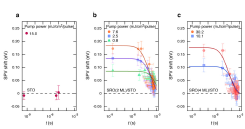Tailoring Photovoltage Responses at SrRuO3/SrTiO3 Heterostructures
I. Matsuda Group
Strontium titanate (SrTiO3) has been one of the well-known transition-metal oxides and its perovskite crystal structure has enabled us to design a rich variety of metal-oxide heterostructures by epitaxial growth of oxide films. Recently, its photo-induced response has also attracted technological interests for usages of solar cells, photo diodes, photoelectrolysis, and photocatalysts. In such applications, the photovoltage effect is the most fundamental optical response and one needs to clarify the mechanism for designing and upgrading the systems. The surface photovoltage (SPV) effect is induced by photo-excitation, followed by spatial separations of carriers (holes and electrons) between the surface (interface) and the internal bulk. The effect is sensitive to the surface/interface band alignment and, thus, it is expected to improve the optical response by electronic design of the heterostructure.

Fig. 1. Time dependence of the energy shifts of the surface photovoltage (SPV) effect after the optical pumping, traced by the time-resolved Sr 3d core-level photoemission measurements at a) SrTiO3(STO), and b) SrRuO3 (SRO)(2 ML)/ SrTiO3 and c) SrRuO3 (4 ML)/ SrTiO3.
By making element-selective time-resolved soft X-ray photoemission experiments at SPring-8 BL07LSU, we demonstrated that the photovoltage response can be enhanced in more than two orders of magnitude in SrTiO3 by the epitaxial growth of 2 monolayer (ML) of SrRuO3 thin film (0.8 nm), as shown in Fig.1. Moreover, we determined life-time of the photo-excited carriers in the perovskite heterostructures. Performance of the optical response matched with expectations from the band alignments. Our approach is fundamentally applicable for a variety of oxide heterojunctions and, therefore, it can be useful in fabricating the better opto-electronic devices such as high-efficient photo-detectors and solar cells.
References
- [1] R. Yukawa, S. Yamamoto, K. Akikubo, K. Takeuchi, K. Ozawa, H. Kumigashira, and I. Matsuda, Adv. Mater. Interfaces 3, 1600527 (2016).
